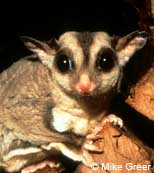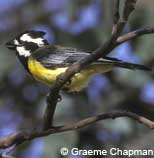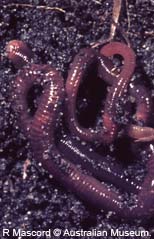About Woodlands
Meet the Animals
Conservation Tips
Puzzles
Further Info
A surprising number of animals use eucalypt trunks for foraging and shelter. Arboreal marsupials, such as the Sugar Glider, often use their lower incisors to tap into trunks to obtain sap. Large, old trees are particularly favoured. The shedding bark found on some eucalypts is also important. Crested Shrike-tits, for instance strip bark to find insects. The Marbled Gecko finds food and shelter under bark. Some trees shed as much as one tonne of bark per year. This fallen material, together with ‘nutrient cycling’ animals such as cockroaches and earthworms, can improve local soil conditions.


Sugar Glider Petaurus breviceps
Sugar Gliders are found throughout eastern and northern Australia (including Tasmania) as well as in Papua New Guinea and Irian Jaya. They are not endangered, but are a protected species within Australia.
Key habitat needs: The sugar glider requires hollows in which to nest in a group of 15-30, enough trees to use as stepping stones to navigate the landscape and sweet sap from certain types of eucalypt and acacia trees on which to feed.
Did you know? One colony of sugar gliders can eat up to 200 kg of Christmas beetles in a year. These insects are serious pests on eucalypt trees and cause eucalypt dieback.

Crested Shrike-tit Falcunculus frontatus
The Crested Shrike-tit is found throughout south-east Australia, from Queensland NSW, Victoria and south-eastern South Australia. Some populations are also known in the Northern Territory and Western Australia.
Key habitat needs: Crested Shrike-tits inhabit eucalypt woodlands and forests and favour river red gums for their flaking bark under which they can easily forage for insects and spiders. They use their strong and deep bill to lever bark up in order to find insects.
Did you know? A Crested Shrike-tit's nest is a cup or cone shape, made out of grass, bark and spider webs. It is usually situated in a fork high in a tree.

Marbled Gecko Christinus marmoratus
The Marbled Gecko is common throughout Victoria and southern NSW. It is also found in southern South Australia and Western Australia. It occurs in cool dry forests and woodlands and can even be found in urban parks.
Key habitat needs: The nocturnal Marbled Gecko needs plenty of fallen timber and leaf litter under which to forage for insects at night. It also likes rocks under which to shelter.
Did you know? Geckos have a long tongue with which they clean the surface of their eyes - geckos have no eyelids with which to do this.

Native Cockroach Polyzosteria limbata
There are over 400 species of Native Cockroach throughout Australia. Many are nocturnal.
Key habitat needs: Native Cockroaches feed on pollen, bark and leaves. They inhabit forest, woodlands, grasslands and coastal heathland.
Did you know? In order to ward off would-be predators some native cockroaches can emit an unpleasant odour.

Earthworm
Australia has over 1000 species of native earthworms. Although most species need wetter soil conditions, a few species do occur in arid environments. The largest native Australian worm is the giant Gippsland earthworm which averages 80 cm in length and is 2 cm in diameter. Their activities contribute billions of dollars worth of ecosystem services in terms of improving soil quality.
Key habitat needs: Earthworms are mainly found in soil, leaf litter and under stones and logs. Most species prefer wetter areas with plentiful vegetation. Native earthworms are threatened by land clearing and the invasion of introduced species which are usually common in suburban areas.
Did you know? Earthworms breathe through their skin. This is why they need moist soil in which to live - to keep their pores healthy. The dryer the soil, the deeper they have to dig their tunnels. Earthworms will sometimes emerge from the ground at night - little light sensors on their heads let them know when it is dark enough to come out.

